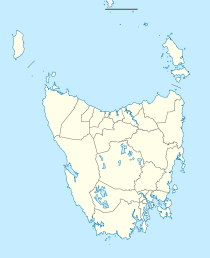Gretna, Tasmania facts for kids
Gretna is a small country area in Tasmania, Australia. It's located in two local government areas: Central Highlands and Derwent Valley. Gretna is about 20 kilometers (12 miles) south-east of a town called Hamilton. In 2016, about 211 people lived in Gretna.
This place used to be called Stony Hut Plains. For a long time, the post office in Gretna was known as Macquarie Plains. Gretna has a postcode of 7140.
Quick facts for kids GretnaTasmania |
|||||||||||||||
|---|---|---|---|---|---|---|---|---|---|---|---|---|---|---|---|

B class locomotive at Macquarie Plains station
|
|||||||||||||||
| Population | 211 (2016 census) | ||||||||||||||
| Postcode(s) | 7140 | ||||||||||||||
| Location | 20 km (12 mi) SE of Hamilton | ||||||||||||||
| LGA(s) | Central Highlands, Derwent Valley | ||||||||||||||
| Region | Central, South-east | ||||||||||||||
| State electorate(s) | Lyons | ||||||||||||||
| Federal Division(s) | Lyons | ||||||||||||||
|
|||||||||||||||
A Look Back in Time
Gretna officially became a "locality" (a specific area with a name) in 1959. This means it was given its official name and boundaries.
Before that, the post office in the area opened in 1932 and was called Macquarie Plains Post Office. It later changed its name to Gretna in 1907.
Where is Gretna?
The River Derwent flows along the south-western and part of the southern edges of Gretna. This river is an important natural feature.
A main road, the A10 route (also known as the Lyell Highway), goes through Gretna from south to north-west. Two smaller roads branch off from it. The C181 route (Marked Tree Road) heads north through Gretna. It eventually meets the B110 route (Hollow Tree Road) in a nearby area called Hollow Tree. The C183 route (Bluff Road) goes north-east towards Elderslie.
Famous Places
Gretna is home to three special buildings that are important for their history. They were once listed on the Register of the National Estate, which was a list of Australia's important heritage places. Today, these three, along with five other properties, are on the Tasmanian Heritage Register. This register helps protect places that are important to Tasmania's history.
- St Mary the Virgin Anglican Church: This local church was built in 1848. It's a beautiful old building that has been part of the community for a long time.
- Glenelg House: This house was designed by a famous architect named Henry Hunter. It was finished in 1878 and built for the Downie family.
- Clarendon House: This historic house was built even earlier, in 1821, by William Borrodaile Wilson.


